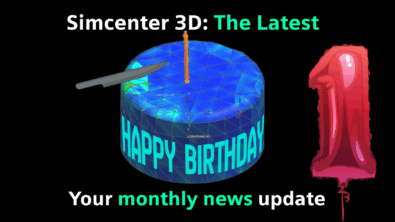Simcenter FLOEFD v18.0: What’s New? – Part 2

Simcenter FLOEFD v18.0: What’s New? – Part 2
In Part 1 of the v18.0 post, you saw some new features of Simcenter FLOEFD such as battery cooling, OneSim, and auto calibration of semiconductors. Now in Part 2, you will see the rest of the enhancements of Simcenter FLOEFD v18.0.
Smart PCB
A new Smart PCB feature represents a PCB as a Network Assembly with a large number of nodes. The network assembly is constructed from the layer images providing precise conductivity and capacity map of the PCB’s internal structure. The Smart PCB also allows importing effective conductivity map as a *.csv or *.trmexport file (requires EDA Bridge module).
 Various levels of resolution of the Smart PCBs thermal conductivity.
Various levels of resolution of the Smart PCBs thermal conductivity.
Radiation Related Functionalities
There are a handful of new functionalities, namely:
- It is now possible to calculate absorption/emission by H2O and CO2 fluids in combustion analysis.
- For a combustion analysis, you can now estimate the mass fraction of non-equilibrium Nitric Oxide (NO) based on the Thermal-NO (Zeldovich-NO) mode. The Thermal NO mechanism is a predominant source of NOx in gas flames at temperatures above 1800 K (requires Advanced module).
- Radiation: On-Orbit radiation. For a spacecraft orbiting a celestial body (a planet or a moon), the main sources of environmental heating are direct sunlight, sunlight reflected by the celestial body (albedo), and the infrared (IR) energy emitted by the celestial body itself. Such on-orbit radiation can now be simulated for a given celestial body and orbital characteristics. All planets and the moons are pre-defined in the database (requires ADVANCED module).
 The orbital parameter and setup for orbital radiation and thermal simulation.
The orbital parameter and setup for orbital radiation and thermal simulation.
Lighting Related Functionalities
- Film motion: Consider water film motion on surfaces due to gravity and aerodynamic forces for fogging/defogging analyses (requires LED or Advanced module).
- Solar radiation direction: you can now visualize the direction of solar radiation at the loaded time moment and in animations.
- Coating surfaces: You can assign a radiative surface with defined emissivity to a surface of a semi-transparent solid to represent a metal coating on semi-transparent media (requires LED module).
- Flux measure on semi-transparent surfaces: you can now quantify incoming radiation flux on semi-transparent surfaces.
- Radiation: Setting Radiation Temperature other than the global Environment Temperature for a specific wall. A new “Wall to environment wall” type of radiative surface allows setting for a particular surface a radiation environment temperature other than the global one defined in the General Settings. This type of condition can be used in case different sides of the model undergo radiation with different environment temperatures.
Enhanced User Experience
- Component Explorer: Allows you to list material and source conditions applied to components in one table. So now you can easily change materials, LEDs, two-resistors as well as edit material properties and heat generation rate values for multiple components quickly.
- Comparing multiple models in Simcenter FLOEFDView: Easily compare results of multiple variations of the same model with the new FLOEFDView (a free Simcenter FLOEFD results viewer). To use this function, the results must be based on the same newly available Scene template and saved in the Simcenter FLOEFDView file format (*.efdscene). When opened in Simcenter FLOEFDView such results can be synchronized for orientation, plot visibility, and even the pallet’s minimum and maximum values. These Scene files can also be created for multiple projects at once with the batch results processing.
Improved User Productivity
- Embedded HEEDS: The latest release of Simcenter FLOEFD offers the option for use of a new powerful design exploration engine in the Parametric Study functionality. You can now access the efficient and robust optimization and search functionality of the SHERPA algorithm from HEEDS™ embedded into Simcenter FLOEFD. The new functionality simultaneously leverages multiple global and local search strategies, and adapts the search as it learns more about the design space. It requires no algorithmic search expertise on the part of the user and incorporates user intuition through its collaborative search capabilities. The process allows you to identify higher-performing families of designs with minimal simulation time and cost (requires additional Embedded HEEDS module).
 An IGBT cold plate multi-parameter optimization study with the HEEDS embedded module in Simcenter FLOEFD.
An IGBT cold plate multi-parameter optimization study with the HEEDS embedded module in Simcenter FLOEFD. - Improved Geometry variations through Variables (Solid Edge), Expressions (NX), Parameters (Creo) or Equations (Simcenter FLOEFD Standalone) as well as the new Simcenter FLOEFD project parameters which can be used in boundary conditions and parametric studies.
- Improved API to create a project from templates and face based (color or name) boundary conditions. The API is available for Visual C++, Visual Basic and Visual Basic for Applications. This can be leveraged to create highly automated workflows.
- Name Templates have been introduced to define the boundary condition name at its creation.
- New feature goals can be created together with the boundary condition and are linked to it. When changing the reference of the boundary condition the goals will be automatically linked to the same reference and if the boundary condition is deleted, the goal is deleted with it.
- The import of Siemens NX materials is available if materials are applied to components in NX and will be automatically defined as boundary conditions and used for the simulation.
For additional information and a complete list of new capabilities, please go to the Support Center site (https://support.mentor.com) or read the release highlights file provided with the installation package.


